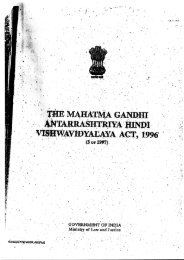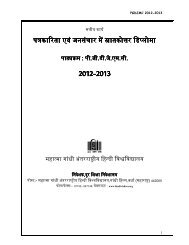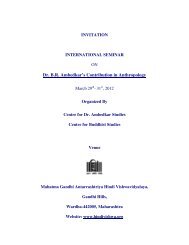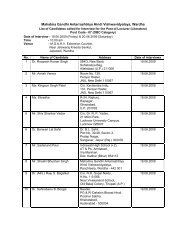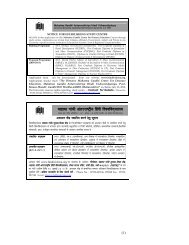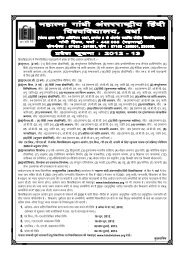Mamta Kalia
Mamta Kalia
Mamta Kalia
Create successful ePaper yourself
Turn your PDF publications into a flip-book with our unique Google optimized e-Paper software.
you. No one has read them in the last one<br />
hundred years. Read them and then we<br />
shall talk further.”<br />
These letters are great achievements of<br />
the novel – outstanding examples of prose<br />
drenched in love. Victorian morality that<br />
considers all contact between men and<br />
women outside marriage taboo matches<br />
amazingly with eastern notions. The sanctity<br />
of the woman’s body and the fear of it being<br />
polluted through sexual contact dwarfs<br />
before the exalted love of Mitva and<br />
Chhutku. But Chhutku is missing in direct<br />
narrations.<br />
During questioning by the police, it<br />
comes out of Allen’s mouth that when the<br />
murder took place he was with the girl, but<br />
in the court he maintains silence. Allen’s<br />
silence itself becomes the cause of his being<br />
sent to the gallows. This is an outcome of the<br />
Victorian moral values surrounding the<br />
purity of a lady. If we speak in terms of the<br />
frame of the novel, this silence finds its voice<br />
the first time in Fr Camillus’ diary. But here<br />
too all he says about the girl is: “Can you<br />
cause a bad reputation to the person you<br />
love?”<br />
Vibhuti Rai has used the technique of<br />
visual images too in this novel. The ghost of<br />
Madam Ripley Bean shows some scenes to<br />
the journalist. This is in fact a re-adaptation<br />
of one of the ancient techniques of Indian<br />
narrative tradition. Bhavabhuti in his Uttara<br />
Ramacharita shows the past story of Rama<br />
through this technique. From the scenes the<br />
ghost of Madam Ripley Bean, playing the role<br />
of a video operator, shows the journalist, fill<br />
the blanks of which we get clues from Allen’s<br />
158 :: April-June 2010<br />
letters and Fr Camillus’ diary. Now the<br />
alternative scenario is revealed, in which we<br />
meet Allen and the girl Chhutku. Here<br />
contact between the pahadi [mountain]<br />
culture and colonial culture is at a different<br />
dimension. The love of two lovers who have<br />
connections with the ruling class finds<br />
expression through pahadi songs and<br />
folklore. The Victorian fear of ‘going native’<br />
is meaningless here. The letters and visual<br />
images are estimable parts of the novel; at<br />
the same time, these non-traditional<br />
mediums are also tools in pursuing the truth.<br />
Actually, there are three pivots to the<br />
frame within which the love story takes<br />
shape – Fr Camillus’ diary, Allen’s letters, the<br />
scenes shown by the ghost of Madam Ripley<br />
Bean. Seen in the context of this frame, Allen,<br />
who is recorded as a murderer in<br />
government documents, emerges as a<br />
playful lover and a living human being.<br />
In the contemporary memories of<br />
Mussoorie, Madam Ripley Bean exists as a<br />
miserly, mean old woman who fears her<br />
father as a teenager does even at the age of<br />
seventy-five – and this even though it has<br />
been years since her father died. In the<br />
construction of the novel, ghosts contribute<br />
in several ways. There is no need to mention<br />
here that in fact it was her father’s ghost that<br />
Madam Ripley Bean feared. The seller of old<br />
books, who had purchased Madam Bean’s<br />
father’s books, says: “When I started going<br />
there, it had been many years since the<br />
father died. But he used to visit her every<br />
day and rebuke her severely, though<br />
Madam was already approaching old age<br />
then.”




